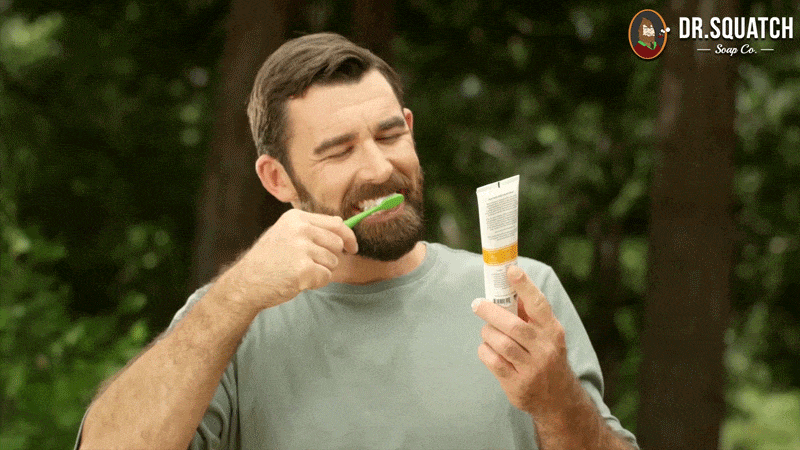All toothpastes contain a range of ingredients which perform different key functions.
Surfactants, one of the main functional ingredients in toothpaste, are cleansing agents that foam up to wash away food and grime. A range of other ingredients like abrasives (polishing ingredients which help rub off particles and stains), antimicrobials, flavoring agents, and whitening agents are other common ingredients in toothpaste formulas.
All of these toothpaste ingredients can be either synthetic or naturally-derived. We’ll discuss those key differences below.
Questionable Synthetic Ingredients in Toothpaste
Most people would be surprised to see common synthetic ingredients that they avoid using on their skin or hair in standard toothpastes.
The most common surfactant used in standard toothpaste is Sodium Lauryl Sulfate (yes, the same SLS commonly found in big-brand personal care shower products), due to its harsh cleansing power and cheap cost. This ingredient is responsible for the mouthful of foam you’ve grown used to getting when brushing. Sadly, many of the same reasons that you want to avoid using skin and hair products with SLS apply for toothpaste as well – like its harshness and potential for irritation.

Triclosan, an antibacterial agent, is another ingredient that was prevalent in toothpaste for years. More public attention was turned towards this ingredient after the FDA banned it from use in Over-the-Counter antibacterial hand soaps, following questions around its benefits and safety compared to normal soaps. Curiously enough, despite being removed from the FDA list for effective use in antibacterial hand soaps, Triclosan was still allowed in toothpastes until bad publicity pressured the last US toothpaste brand to remove it from their products in 2019.
Other common synthetic ingredients found in toothpastes include parabens, artificial dyes and flavors, microplastic thickening agents, and harsh whitening ingredients like hydrogen peroxide. All in all, people should be mindful of what’s in their toothpaste since the potential for absorption into the body is so high during brushing.
Is Natural Toothpaste Effective?
Luckily, there are alternative products that contain naturally-derived toothpaste ingredients that are just as effective as some of those questionable synthetic ingredients of the past.

Natural Toothpaste Ingredients: Effective Alternatives
There are a range of plant-derived surfactants that can be used in natural toothpaste that are less harsh than SLS (Sodium Lauryl Sulfate). For example, Sodium Cocoyl Glutamate is a mild, vegetable-based surfactant that’s derived from sources like coconut, palm and corn. This natural alternative gently and effectively cleans your teeth and still provides the foamy brushing experience that we all love.
Natural toothpastes flavored with essential oils are more transparent alternatives to artificial flavorings. And instead of synthetic microplastics, naturally-derived gums can be used as natural thickeners.
Standard Synthetic Toothpaste Ingredients
-
Sodium Lauryl Sulfate
-
Artificial Flavors & Dyes
-
Microplastic Thickeners
-
Harsh Abraisives
Dr. Squatch Natural Toothpaste Ingredients
-
Plant-Derived Surfactants
-
Flavor from Essential Oils
-
Natural Gum Thickeners
-
Whitening from Natural Clay

Hydroxyapatite: The Natural Building Block of Your Teeth
Most of us have heard that the mineral calcium is important for the health of our bones and teeth. Calcium is an integral part of a larger crystalline complex called Hydroxyapatite, which is a naturally occurring calcium-based mineral comprised of calcium and phosphate. Hydroxyapatite sounds like a scary chemical, but it’s actually a natural mineral that makes up 75% of our body’s bones by weight, and is also the major component that makes up our tooth enamel!
This naturally-derived mineral is highly compatible with our teeth, since it’s the exact mineral that they’re made of. As a key ingredient in our natural toothpaste, it provides a range of proven benefits: remineralizes and strengthens the enamel, helps prevent the accumulation of plaque, whitens without the use of harsh chemicals, and fights against tooth sensitivity.

With natural ingredients like this, you can feel confident knowing that there are natural toothpaste ingredient alternatives that don’t just meet, but exceed the performance expectations of synthetic toothpastes.
Why You Should Care: Your Oral Health
If you care about the ingredients in the products you use (like your soap and shampoo), be sure to take a look at the ingredients in your toothpaste too, so that you can make good choices for your overall health!
Oral health is one of the most important aspects of your overall health, and poor oral health can actually lead to higher risks of health problems throughout the body. Choosing a toothpaste that provides a proper balance of cleansing, whitening, and enamel health support is key. There are a growing number of natural ingredients out there that offer these benefits without making you resort to the harsh, questionable ingredients of synthetic pastes.
 SHOP NATURAL TOOTHPASTE
SHOP NATURAL TOOTHPASTE
Hopefully you’re now armed with a bit more knowledge on what’s in your toothpaste and the ingredients in toothpaste to look out for, so you can make smarter choices when you brush.
As always, keep Squatchin!
ABOUT THE AUTHOR
Tags: mens health, natural care, natural ingredients, natural toothpaste, product information, toothpaste, toothpaste ingredients

















Leave a Reply
Your email address will not be published. Required fields are marked *